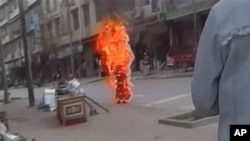A growing number of Tibetans in China have set themselves on fire in recent months to draw attention to what they consider to be Beijing’s cultural and religious repression. This wave follows the self-immolation of dozens in Tunisia and other countries swept up in the Arab Spring. The suicidal act, while making new headlines, has a long history of being used as a political tool around the world.
In 1963, Buddhists in South Vietnam were facing discrimination by the government of Ngo Dinh Diem, a member of the Catholic minority. The treatment became intolerable for many, and one monk, Thich Quong Duc, made a decision that would have a resounding impact on Vietnam and beyond.
“Thich Quong Duc sets himself on fire, and that becomes a major news story all over the world,” recalled Michael Biggs, a sociologist at Oxford University and the author of “Dying Without Killing,” a history of self-immolations.
The iconic image of the monk engulfed in flames was captured in a prize-winning photograph.
“And as a result of that, not only do other people in Vietnam start using that action, but other people in other places completely unconnected with Vietnam start using it as well,” said Biggs.
Some of these images may be disturbing.
Beyond borders
These acts of desperation have been mostly concentrated in Asia, but there have also been incidents in Eastern Europe, North Africa and the United States.
In 1969, Jan Palach set himself on fire in then-Czechoslovakia to protest the occupation of his country by Soviet troops.
In South Korea, pro-democracy and labor rights advocates used self-immolation as a political tool before the country became democratic.
And when India’s government pursued affirmative action policies in 1990, students set themselves on fire to protest the decision to give underprivileged castes more opportunities.
Personal is political
Self-immolation does not always bring about the desired reforms, but the decision to burn oneself to death is a powerful outlet, particularly in countries where there is no democratic means to address injustices.
Rodger Baker of the global intelligence firm Stratfor says there are a number of motivating factors.
“It is an attempt to draw attention to, in a very drastic manner, some form of political change or political injustice. So, when you see it with the Tibetans, it is about the Chinese domination of Tibet, but it also may be seen as an economic protest. What we saw in Tunisia, for example, was political, but it was also economically motivated,” he said.
Tunisian street vendor Mohamed Bouazizi set himself on fire in December 2010, an act widely seen as the start of the revolution that brought down the government of Zine al-Abidine Ben Ali and fueled the Arab Spring. Others in North Africa followed in his footsteps, showing that self-immolation has the ability to cross not only national boundaries, but religious barriers as well, said Baker.
“In Islam, as in Christianity, the concept of suicide is very much against what they do, and in some sense in North Africa, it’s sort of like saying, ‘I’d rather die in hell than live on Earth,’” he said.
Silent stoicism
Baker says one of the reasons why self-immolation is so powerful, rallying supporters to a cause and drawing international attention, is because of its visual imagery.
“You don’t see self-immolators who are running around screaming in pain. The whole point is to have that added element in many ways of stoicism. For most people, the concept of even burning yourself on the stove is something that you can already feel just by talking about, and it’s extremely painful. The idea of lighting oneself on fire is beyond the level of pain that most people are willing to endure,” he said.
Self-immolators are sometimes called “terrorists” by the governments they’re protesting. That’s not the case, according to Biggs.
He says suicide bombers rely heavily on organization, access to bomb-making techniques and logistical support. But self-immolation is different.
“It’s something that ordinary people, occasionally, almost spontaneously decide to do as a kind of an act of will of their own individual decision,” he said. “And often we find organizations condemning the act and telling the people, ‘No, no, we don’t want people to do this.’”
State action
Governments also find it difficult to respond to such actions, says Baker.
“Even when we see, for example, a group of people self-immolate, rarely are they coming out of a larger group who says, ‘Why don’t you guys go burn yourselves, and next week we’ll go burn ourselves,’” he said. “And this is one of the challenges China has had because they are trying to portray it as, ‘Okay, the Dalai Lama is telling these people to go out and burn themselves.’ But it’s a very difficult argument for them to make that that is the case.”
Beijing has, in rare cases, seen self-immolation work in its favor. When followers of the Falun Gong movement carried out a series of self-immolations in China more than a decade ago, one woman took along her daughter to Tiananmen Square, where the girl also set herself on fire.
Biggs says that is one of the only cases of self-immolation in recent history where the act hurt the cause and helped the government the activist was rallying against.
VOA News will host a Google Plus Hangout to discuss this issue and other matters relating to China. Please join William Ide for a discussion at 0330 UTC Thursday.












